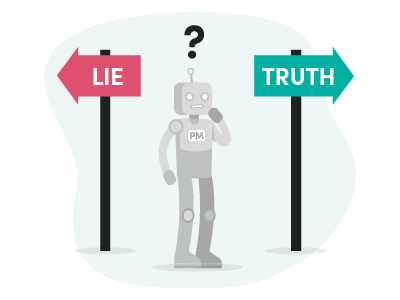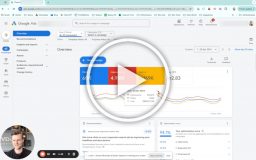Summary
- Performance Max is a misunderstood campaign type
- Most tactics people are told to improve performance have a negligible effect
- Learning to ascertain a good tactic from a bad tactic is more important than ever
- You can, and should, optimize Performance Max campaigns to get more out of Google Ads
Intro
Content about Performance Max has taken off since its inception. It’s like people can’t get enough info about the campaign type. One of my best pieces of content from 2023 was a post about how much people wanted content about Performance Max.
For this reason, I often see Performance Max claims where creators are guessing at best and not testing whether or not it works. At worst, they don’t know what they’re talking about or infer things they’ve heard others say without context. In some cases, they are simply making a mountain out of a molehill.
As with most lies, there is a grain of truth in them. The six lies in this article have come from somewhere. I’ve therefore highlighted in what circumstance each lie has a grain of truth in it.
It’s all about nuances. Google Ads is not a list of best practices that work for every single business. Even within eCommerce, there are several individual strategies that fit different businesses.
Let’s dig into the 6 lies, beginning with one that’s been going around since the start, and because of it, we actually lost a client within a month of Performance Max coming out.
Lie 1) Performance Max is a Full-Funnel Campaign
- Evidence:
- At least 90% of traffic is Google Shopping, which isn’t an upper funnel campaign type
- Setting the same ROAS target for Shopping Ads and upper funnel YouTube Ads hasn’t been viable
This lie 100% started with Google, and I’m confident that it wasn’t intended as a lie. I remember sharing the stage the company rolled out in 2022 when they proclaimed that this was the campaign type to replace all campaign types.
As we now know, this didn’t happen. I do not know any serious Display or YouTube eCommerce advertisers who have replaced their campaigns with Performance Max.
What it means for you:
You shouldn’t believe that Performance Max fills up any type of upper funnel your business might have.
The grain of truth in the lie:
It could be full-funnel one day. I still believe there is a huge untapped potential for Google to truly use audience data for its advertising channels.
We all know the traditional funnel where someone clicks an ad on Google, and then our job is to retarget them, right?
But we all either just blast them with retargeting until they buy via Performance Max or don’t do it at all.
I feel there is a massive opportunity to be smarter about retargeting, and deep down, I thought Performance Max could be the answer. Instead, we have a black box with even less info than before.
Or, what if Performance Max could take a chapter out of Meta’s playbook and use similar audiences much more often? Imagine a person searching for a new natural deodorant that helps with odor control who also watches CrossFit videos and lives in a hot climate.
Why can’t we target this kind of person effectively on YouTube?
To this day, I do not understand why Google can’t utilize all its data. Meta has been able to build an advertising giant twice (remember iOS14?) on this exact framework.
I still hope that Google will find a way to break through to this kind of advertising in the future, but for now, let’s not kid ourselves that Performance Max is full-funnel marketing.
Lie 2) Optimizing Audiences Is Key to Performance Max Success
- Evidence:
- Changing your audiences for an existing, well-performing Performance Max campaign has no impact on performance.
- Removing audiences from existing campaigns has no negative impact
- When creating a P-Max campaign, it’ll actively tell you that it starts with the audiences you’ve added and then expands to other audiences.
What it means for you:
Stop “optimizing” your campaigns by changing audiences (or search themes).
Stop creating asset groups for specific audiences. As evident by lie 1), you rarely need to spend much time optimizing for where “upper funnel” creatives go.
Both are unnecessary and mainly a waste of time.
The grain of truth in the lie:
When you first turn on a Performance Max campaign, it’ll use the audiences you add and show ads exclusively to them. But only initially.
It’ll quickly expand beyond the audiences you’ve added.
Let me summarize our viewpoint:
- Are audiences important in today’s world? Yes, 100%.
- Can you do cool audience things when you have very large budgets in mainstream niches? Absolutely.
- Does Smart Bidding already bid for every single audience it has access to without you adding them to Performance Max? Yes.
- Is this important for 98% of you reading this article? No.
I’ve gotten a lot of stick for these statements. They say, “But Andrew, it can’t hurt, can it?”. No, it can’t, but at the same time, it doesn’t help either, so it’s a waste of your time.
If your agency sent you a report of their optimizations last month and logged any time spent looking out the window, you wouldn’t be happy either. Same thing for audiences.
No, it doesn’t hurt, but it certainly doesn’t help.
The fact is that we run multi-million dollar campaigns across most countries in Europe and the US. We do not actively use audiences because whenever we test the effect, we don’t see any.
The reason is that search intent is such an important driver in conversion rates.
You don’t run different campaigns for the keyword iPhone charger based on whether they went to college or not, do you? No, because the performance difference isn’t there. Someone searched for an iPhone charger because they need an iPhone charger.
Whether that person lives in Arizona or New York or went to college has no impact whatsoever.
Search intent trumps audience data for most eCommerce businesses, and where audience data can be used, Smart Bidding is already using it behind the scenes.
Lie 3) Aggregate Everything in One Campaign to Maximize Data & Help the Algorithm
- Evidence:
- Campaign structure tests at SavvyRevenue
- Different products have different needs, sales cycles, promotions, etc., so relying on a single campaign often leads to sub-optimal results
What it means for you:
Creating 2-5 Performance Max campaigns is often the sweet spot for campaign structure.
The grain of truth in the lie:
You can definitely have too many Performance Max campaigns (think one per category). It makes it too hard for the algorithm to gain momentum (or use audience data) and opens you up to human error (products excluded across all campaigns, etc.).
Spreading budget across dozens of campaigns will result in campaigns limited by budget while others are spending too much on Display because it sees there is budget left.
The solution isn’t to create only one campaign, though, but to think of what levers you’re going to want to pull.
Here are three examples:
- Hero vs. Accessories:
- Campaign 1: Hero products only (Casper mattresses)
- Campaign 2: Accessories only (Casper pillows and bedding)
- On Sale vs. Not On Sale
- Campaign 1: Products on sale = Boost with Seasonal Bid Adjustment
- Campaign 2: Products not on sale = No Seasonal Bid Adjustment
- Bestseller vs. Non-Bestsellers
- Campaign 1: ROAS target of 500%
- Campaign 2: ROAS of 600% (or even better: Standard Shopping)
Lie 4) Performance Max Replaces Shopping, Search, Display, & Video
- Evidence:
- Different campaign types require different ROAS targets
- Display & Video has not caught on in Performance Max
What it means for you:
Most advertisers should use Performance Max to prove that Google Ads is a viable channel for them.
If you can’t set up a $300/day basic P-max campaign with the correct settings and hit your target, then there is most likely nothing an agency can do to help you.
The grain of truth in the lie:
Yes, you can serve Search, Shopping, Video, and Display ads with Performance Max, but that doesn’t mean a P-Max-only structure is the optimal way for you to run Google Ads.
Google will come out and recommend people switch Google Shopping to P-Max, but have you ever heard them tell you to turn off all your Search, Display, or YouTube Ad campaigns?
You’ll never hear that recommendation, and the reason is that P-Max doesn’t replace Search, Video, or Display.
Lie 5) Strong Video & Image Assets are Key to Success in Performance Max
- Evidence:
- You rarely get any meaningful traffic from Display or YouTube.
What it means for you:
Spending any significant resources on creative for Performance Max has, at best, a minor impact, and worst (and most commonly) does not make any impact whatsoever.
Whenever you do test running video or display creatives via Performance Max, you should keep a close eye on how these networks perform in spend and revenue. This is the only way that you can understand if it is worth investing in better Display & Video creatives.
The grain of truth in the lie:
The better your creative is, the better performance your campaigns serving these creatives will be. That’s been a fact as long as advertising has existed.
The problem is that we can’t control factors like these in P-Max:
- Force spend on new creatives to test them
- Set different goals for Video or Display ads
We can’t set a 200% ROAS target for YouTube Ads, a target of 500% for Shopping Ads, and a 1000% target for branded keywords inside the same Performance Max campaign.
Currently, there isn’t even a good report for how much spend a creative got and what audiences it was exposed to.
So, we can’t know for certain that investing $1,000 (and time) in a new video for YouTube will result in P-Max spending any money on it.
I hope we will be able to do it one day, but until we can, feeding better creative is the best solution.
Lie 6) Without Brand Terms in Performance Max, Non-Brand Performance Suffers
- Evidence
- We run all Performance Max campaigns with brand exclusions and should be out of business if this hurt performance
- We routinely remove brand from Performance Max campaigns when onboarding clients. Again, we should see a noticeable drop off in performance if it mattered (and should lose clients quickly).
- A high-performing, existing P-Max campaign gets so much data elsewhere that your brand terms are a drop in the bucket
What it means for you:
You can and should exclude all brand terms from your Performance Max campaigns.
Without doing so you’re skewing your ROAS numbers, and Performance Max is not expanding into enough non-branded search inventory when it can just feed off your branded terms.
The grain of truth in the lie:
We run very few campaigns for startup eCommerce brands at Savvy. We’re typically not the agency you go to when going from zero to one, but from one to a million. Hence, one of our client selection criteria is proof of concept.
But my good friend, Menachem Ani, has told and shown me several times that it helps them scale brand new Performance Max campaigns for new advertisers.
I can’t dispute the evidence he provides, so I’ll say that there is something about how brand terms can help in the beginning. But once you’ve scaled, it’s crucial you get your terms out of there.
In Conclusion: Don’t Trust Everything You Read
As someone who’s been in the Google Ads world for many years, and knows practically everyone, I can tell you this: most of what you read comes from a case study of one.
Only a few trusted people I know write pieces based on a broad range of cases.
Most of the advice you read are hot takes based on what someone has seen work once or twice. That doesn’t mean it works most of the time, just that maybe it’s worked a couple of times for this one person for the specific client criteria.
It’s like Google which constantly tries to push Performance Max on our pharmacy client. It’s just not a smart idea for so many reasons. One being the inability to control what messaging goes with what product.
Just because something has worked once or twice, it doesn’t mean it’s the right thing to do for you.
Our jobs in online marketing have gone from being highly technical (remember mobile and desktop device adjustments?) to being more strategic.
For you to keep growing in this industry, you need to learn to distinguish sound advice that fits your marketing strategy and hot takes that sound good.
If you want optimizations that are not just based on a single case, this is the article for you.






